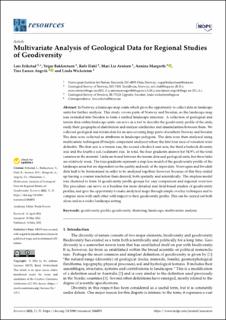Multivariate Analysis of Geological Data for Regional Studies of Geodiversity
Erikstad, Lars; Bakkestuen, Vegar; Dahl, Rolv Magne; Arntsen, Mari Lie; Margreth, Annina; Angvik, Tine Larsen; Wickström, Linda
Peer reviewed, Journal article
Published version

Åpne
Permanent lenke
https://hdl.handle.net/11250/2997919Utgivelsesdato
2022Metadata
Vis full innførselSamlinger
- Publikasjoner fra CRIStin - NINA [2364]
- Scientific publications [1392]
Originalversjon
10.3390/ resources11060051Sammendrag
In Norway, a landscape map exists which gives the opportunity to collect data in landscape units for further analysis. This study covers parts of Norway and Sweden, so the landscape map was extended into Sweden to form a unified landscape structure. A collection of geological and terrain data within landscape units can serve as a tool to describe the geodiversity profile of the units, study their geographical distribution and analyse similarities and dissimilarities between them. We collected geological and terrain data for an area covering large parts of southern Norway and Sweden. The data were collected as attributes in landscape polygons. The data were then analysed using multivariate techniques (Principle component analyses) where the first four axes of variation were definable. The first axis is a terrain axis, the second a bedrock unit axis, the third a bedrock diversity axis and the fourth a soil/sediment axis. In total, the four gradients answer for 54.9% of the total variation in the material. Links are found between the terrain data and geological units, but these links are relatively weak. The four gradients represent a step-less model of the geodiversity profile of the landscape areas but are dependent on the quality and scale of the input data. Norwegian and Swedish data had to be harmonised in order to be analysed together; however, because of this they ended up having a coarser resolution than desired, both spatially and scientifically. The stepless model was clustered to form 16 geodiversity profile groups for easy comparison and regional overview. The procedure can serve as a baseline for more detailed and field-based studies of geodiversity profiles, and give the opportunity to make analytical maps through simple overlay techniques and to compare areas with each other with respect to their geodiversity profile. This can be carried out both alone and in a wider landscape setting. geodiversity profile; geodiversity clustering; landscape; multivariate analysis
